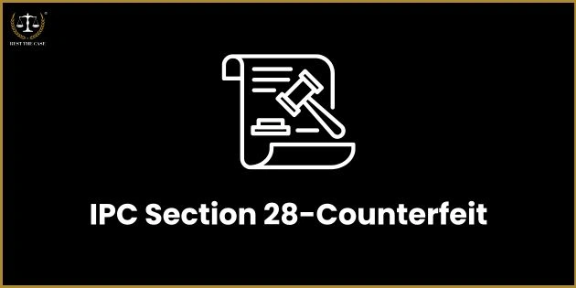
6.1. 1. K Hasim v. State of Tamil Nadu
6.2. 2. Cadbury India Ltd. & Ors. v. Neeraj Food Products
6.3. 3. Nike Innovate C.V. v. Ashok Kumar
7. Conclusion 8. FAQs8.1. Q1. What does ‘counterfeit’ mean under IPC Section 28?
8.2. Q2. Is a perfect copy necessary for something to be considered counterfeit?
8.3. Q3. What are some common examples of counterfeiting?
8.4. Q4. Can I be punished for unknowingly possessing a counterfeit item?
In criminal law, the concept of counterfeiting plays a critical role, especially in cases involving forgery, currency fraud, stamps, documents, and product misrepresentation. But what exactly does the law mean when it uses the word “counterfeit”? IPC Section 28 [now replaced by 2(4)] provides a precise definition that is frequently used in cases of fake documents, forged marks, and fraudulent imitations.
In this blog, we will explore:
- The legal meaning of "counterfeit" under IPC Section 28
- How does it differ from forgery or simple imitation
- Real-life examples of counterfeit acts
- IPC sections that use the term "counterfeit"
- Landmark case laws interpreting this section
What Is IPC Section 28?
Legal Definition (IPC 28):
"A person is said to ‘counterfeit’ who causes one thing to resemble another thing, intending by means of that resemblance to practice deception, or knowing it to be likely that deception will thereby be practiced."
Even if the imitation is not perfect, if the intent to deceive is present, it still qualifies as counterfeit.
This section is the backbone of offences involving false representation of goods, currency, stamps, documents, or signatures.
Simplified Explanation
In simple words, counterfeit means creating or making something look like another original thing, to cheat, trick, or deceive someone.
- It doesn't matter whether the fake is perfect—intention to deceive is enough.
- The law focuses on purpose, not just how good the imitation is.
Practical Examples
- Currency: Printing fake ₹500 notes that resemble real ones is counterfeiting, even if they are not exact copies.
- Stamps or Seals: Making or using a fake notary stamp to sign a document.
- Trademarks: Manufacturing products using a brand name like “Nike” without authorisation.
- Signatures: Copying someone’s signature to make a cheque look valid.
Where Is This Term Used In IPC?
The word “counterfeit” appears in several key IPC provisions, including:
- IPC Section 231: Counterfeiting currency notes or coins
- IPC Section 255: Counterfeiting government stamps
- IPC Section 464: Making a false document (linked to forgery)
- IPC Section 489A-489E: Counterfeiting currency, possession, and use of counterfeit notes
- IPC Section 483–485: Counterfeiting trademarks and property marks
This makes IPC Section 28 foundational to many financial and document-related crimes.
Key Difference—Counterfeiting vs Forgery vs Imitation
Term | Meaning | Focus of Law |
|---|---|---|
Counterfeit | Imitating something to deceive | Resemblance + intent |
Forgery | Creating or altering a document with false intent | False document + deceit |
Imitation | Copying without necessarily deceiving | No criminal intent needed |
Case Laws Interpreting 'Counterfeit'
To better understand how courts apply IPC Section 28, here are some landmark judgments that explain the meaning, scope, and legal implications of "counterfeit" in real-world cases.
1. K Hasim v. State of Tamil Nadu
Summary of Facts:
In this case of K Hasim v. State of Tamil Nadu accused was charged with producing goods that closely resembled original branded goods, though they were not exact copies. The prosecution argued these were counterfeit under Section 28 IPC.
- Held:
The Supreme Court held that Section 28 does not require an exact replica for an act to constitute counterfeiting. A substantial resemblance, with intent to deceive, is sufficient to establish the offense.
2. Cadbury India Ltd. & Ors. v. Neeraj Food Products
- Summary of Facts:
Neeraj Food Products was found manufacturing and selling products that copied Cadbury's packaging and trademarks. The issue was whether these goods were merely deceptively similar or constituted counterfeit.
Held:
In the case of court Cadbury India Ltd. & Ors. v. Neeraj Food Products held that for counterfeiting, proof of deceptive similarity is not required; the existence of imitation goods is enough to constitute counterfeiting. The defendant’s products were deemed counterfeit.
3. Nike Innovate C.V. v. Ashok Kumar
- Summary of Facts:
The defendants were producing and selling goods under the “Nike” trademark without authorization, imitating the branding and appearance of original Nike products.
Held:
In the case of court Nike Innovate C.V. v. Ashok Kumar found the defendants guilty of counterfeiting, ordering a permanent injunction and damages. The court emphasized that the aggrieved party is entitled to remedies including destruction of counterfeit goods and damages6.
Conclusion
IPC Section 28 lays the groundwork for India’s fight against forgery, fake currency, false documents, and brand misrepresentation. It defines the term “counterfeit” broadly to ensure that the focus remains on criminal intent to deceive, regardless of how accurate the imitation is.
Understanding this section is critical for both legal professionals and citizens, especially in today’s world where fake currency, digital forgeries, and counterfeit goods are increasingly common.
If you’re ever involved in a case where resemblance is used to deceive, Section 28 IPC will likely be the legal backbone of the prosecution.
FAQs
To clear common doubts about IPC Section 28, here are answers to some frequently asked questions about the meaning, application, and legal consequences of counterfeiting under Indian law.
Q1. What does ‘counterfeit’ mean under IPC Section 28?
It means making one thing resemble another with the intent to deceive, or knowing that deception is likely.
Q2. Is a perfect copy necessary for something to be considered counterfeit?
No. Even an imperfect imitation qualifies as counterfeit if the intention is to mislead or cheat someone.
Q3. What are some common examples of counterfeiting?
Examples include fake currency, forged stamps, duplicate branded goods, or falsified documents meant to appear genuine.
Q4. Can I be punished for unknowingly possessing a counterfeit item?
Not unless it is proven that you knew or had reason to believe the item was counterfeit.





